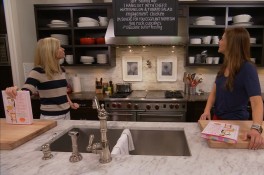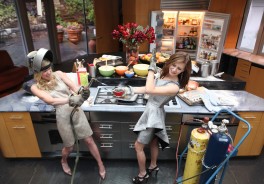
Kitchen Counters
One of the most used areas in the kitchen, your counter top takes a lot of abuse. Hot pots, knives, dishes, spills, dirt and grime. All of it can take a toll on the surface. But there are many different materials out there to choose from, both functional and fashionable. We find out how they measure up.
The Basics
We interviewed builders and interior designers to find out the top-recommended surfaces for counter tops, their advantages, and disadvantages.
-
Granite (Natural Stone)
-
If money is less of an issue, granite tends to be the countertop of choice.
-
They are very elegant and great for home resale value.
-
They are highly resistant to chips and scratches. You can use it as a work surface without a cutting board if you choose.
-
However, granite is expensive and requires routine resealing. Be prepared to reseal it every 2–5 years to help protect it from stains.
-
-
Engineered Stone
-
Just as expensive as granite, these engineered stones are made of natural minerals (often quartz).
-
Stone aggregate is combined with resin and colour pigments.
-
There is a large colour and pattern choice.
-
Easy to clean and highly resistant to heat, stains and scratches.
-
-
Laminate
-
Made from plastic-coated synthetics.
-
Available in endless colours and patterns that can even mimic natural stone.
-
Very durable, but if it does get damaged, it’s difficult to repair.
-
Easy to clean and an economical choice.
-
-
Solid Surface
-
Consists of solid synthetic sheets made by mixing a mineral compound with polyester and/or acrylic resins, resulting in a seamless surface.
-
Available in several colours and finishes and can imitate stone.
-
Highly resistant to stains and cleaning products.
-
Not the best when it comes to heat and scratches.
-
Can have minor nicks and scratches rubbed out using an abrasive cleaner or by lightly sanding.
-
Expensive!
-
-
Ceramic Tile
-
Made from pressed and fired clay, ceramic tile offers a very hard work surface.
-
Many colour and design choices, including patterns, mosaics, and contemporary styles.
-
Easy to install.
-
Very resistant to heat.
-
More prone to scratches and chips than other options, but tiles can be replaced quite easily. Be sure to buy extra tiles so if you need replacements, they’re from the same dye lot.
-
The grout between tiles can be a problem when it comes to stains (there are grout sealers available, which should be re-applied routinely)
-
While you may love the look, you may not like the uneven work surface.
-
Tiles are relatively inexpensive.
-
- Other materials you can choose from include: stainless steel, marble, polished concrete and wood.
Cost
-
When considering your counter top surface, remember to factor in the cost of the materials plus installation, and any maintenance (e.g. granite sealer)
-
Installation costs vary from material to material. Some take quite a lot of skill and so cost more to install, while others are relatively inexpensive.
-
Consider the design of your kitchen counter top space. How many cuts will be required for sink, stove, etc.?
-
When you first go counter top shopping, it’s a good idea to measure the square footage of your counter top space (a rough estimate) so you can really get a good idea what your budget will look like.
-
Colour, texture and pattern can also affect the cost.
-
Custom edge finishing can also be a factor for installation fees. Custom edges include bull-nosed, ogee, sandwiched. If you want to keep your budget down, go with a simple square edge.
- Also remember the back splash (on the wall above the counter). You may not necessarily need one, but you should consider it in your overall cost. Ceramic or glass tile are the most common materials.
TEST CRITERIA
Choosing a counter top that looks good is actually the easy part. Choosing one that is functional, durable, and easy to care for can be the challenge. We took 5 different counter top surfaces and put them through some typical kitchen abuse to see how they stack up against each other.
We tested:
- Ceramic Tile: $14.76 per linear foot
- Laminate: $22 per linear foot
- Engineered Stone: $100-150 per linear foot
- Granite: $100-150 per linear foot
- Solid Surface (we used Corian): $160-200 per linear foot
Durability Test
We stained, burned, chopped, and dropped bowling balls onto our counter top specimens.
-
In the red wine stain test, the ceramic tile’s white grout fared badly. It took a lot of elbow grease to get it clean, which made ceramic tile our last choice.
-
In the bowling ball test, the engineered stone and the laminate didn’t show a mark. The ceramic tile, granite and Corian all marked or chipped.
OUR TOP PICK
The engineered stone and laminate did well in all our tests and we would consider them a good choice. But design won out and our top pick is the ever-popular granite. Its natural look proved to be durable and elegant, despite the fact that our bowling ball did minimal damage…just don’t bowl in the kitchen!










